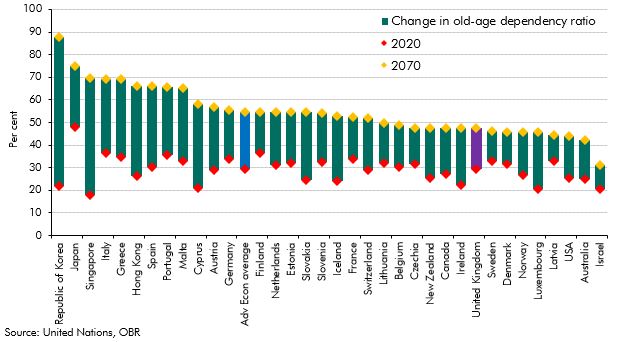The populations of most advanced economies are ageing, placing new demands on these countries' public finances. This box explored why the UK population is forecast to age slower than most advanced economies over the next fifty years.
This box is based on UN data from August 2019 .
The UK is far from alone in having an ageing population. Indeed, the United Nations (UN) projects that the populations of all advanced economies will age over the next 50 years (Chart A).
According to the latest UN population projections compiled in 2019, the UK old-age dependency ratio – which the UN defines as people aged 65 and over as a proportion of the people aged 15 to 64 – is close to the average across advanced economies.a However, the UK ratio is projected to rise by 18 percentage points between 2020 and 2070 – a smaller increase compared to most other advanced economies which, on average, see a 26 percentage point rise. This would leave the UK with one of the least aged populations among the advanced economies in 2070 – in common with the Scandinavian countries, as well as the United States, Australia and Ireland. The most rapid ageing and the highest future old-age dependency ratios are projected across advanced economies in Asia and in Southern Europe.
The UK population ages more slowly than the average across other advanced economies due to higher birth rates and higher net migration rates. Between 2020 and 2070, the UN assumes that the birth rate in the UK will be just above the advanced economy average (at 1.8 births per woman compared to 1.7), and a net migration rate of 2.2 net inward migrants per 1,000 population compared to an advanced economy average of 1.9. Our projections incorporate both lower birth rates (at 1.6) and a lower net migration rate (at 2 on the UN metric) than assumed in the UN projections, which results in the UK old-age dependency ratio in our projections increasing to around 50 per cent in 2070, compared to 47 per cent in these UN projections.
Chart A: Projected old-age dependency ratios in advanced economies

This box was originally published in Fiscal risks and sustainability – July 2022
